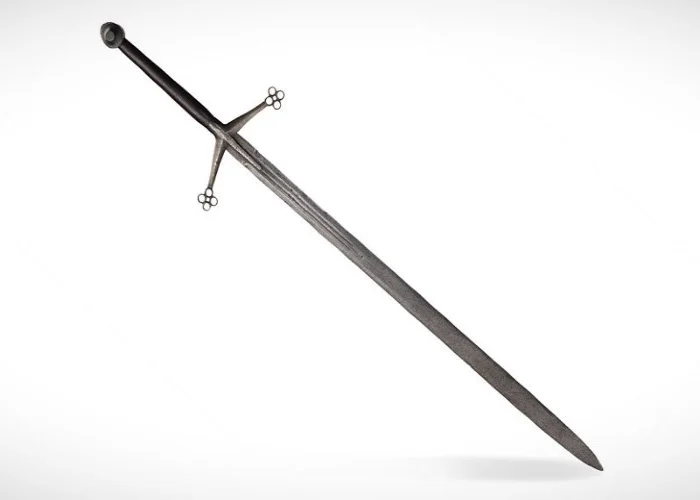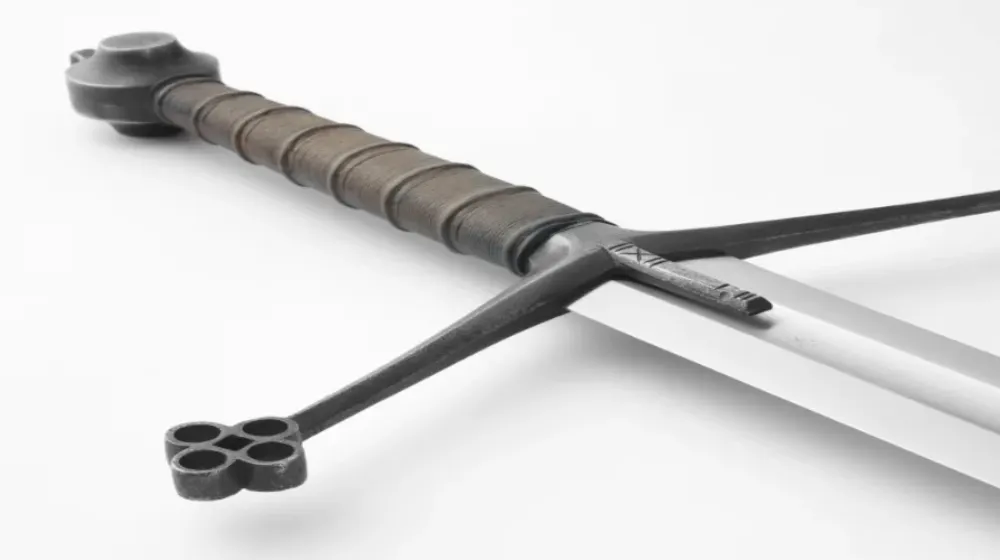The Claymore sword, with its imposing size and rich history, epitomizes the valor of Scottish warriors. Originating in Scotland during the late medieval period, the Claymore became renowned for its distinctive design and battlefield effectiveness.
Its name, derived from the Scottish Gaelic claidheamh-mòr, meaning "great sword," reflects its stature as a weapon of war and a symbol of Scottish independence.Throughout Scotland's turbulent history, the Claymore sword played a crucial role in pivotal battles where Highland clans fought for honor, freedom, and sovereignty. Wielded by skilled warriors, this two-handed sword was crafted for its impressive reach and cutting power and its symbolic significance within Scottish culture.
From the misty Highlands to the fields where clans clashed, the Claymore stood as a testament to bravery and resilience, embodying the spirit of Scotland's martial heritage.
What is a Claymore Sword?
The Claymore sword is a formidable two-handed weapon that originated in Scotland during the late medieval period and rose to prominence from the 15th to the 17th centuries. Known for its robust construction and imposing size, the Claymore was meticulously crafted for cutting and thrusting, making it highly effective in close combat.
Characterized by a long, broad blade that tapered to a sharp point, the Claymore offered exceptional reach and striking power against opponents, particularly those wearing armor. Its overall length often exceeds four feet, with the blade typically measuring 36 to 40 inches.
The hilt of the Claymore was designed with practicality in mind, often featuring a protective crossguard (quillons) that curved forward to shield the wielder's hands during intense engagements.
As a symbol of Scottish martial heritage, the Claymore held significant cultural and historical importance, embodying the bravery and skill of Highland warriors who wielded it in defense of their clans and homeland. The Claymore's historical relevance is evident in the many stories and legends surrounding it, much like the famous Wallace
Sword wielded by William Wallace.
Design and Construction
The Claymore was meticulously crafted to meet the demands of medieval warfare, combining robust construction with practical design elements. Its typically long and broad blade featured a tapering edge facilitating powerful cutting and thrusting motions.
This design allowed skilled warriors to deliver devastating blows against adversaries, leveraging the sword's length and weight for maximum impact.Constructed primarily from high-quality steel, the Claymore prioritized durability and balance.

The hilt was often wrapped in leather or intricately adorned with decorative elements, providing a secure grip and enhancing wielder control during combat. Protective features like the forward-curved crossguard (quillons) shielded the hands from enemy strikes, underscoring the sword's practicality in close-quarters engagements.
The Claymore's design evolved, adapting to changes in battlefield tactics and regional preferences while maintaining its core characteristics. This adaptability ensured its effectiveness and cemented its reputation as a formidable weapon of choice among Scottish warriors.
The craftsmanship of the Claymore is a testament to the skills of artisans who understood the importance of both form and function in creating a weapon that was as beautiful as it was deadly.
Weight and Maneuverability
Despite its imposing size, the Claymore was designed to balance weight with maneuverability, ensuring it remained effective in battle. Typically, a Claymore weighed between 5 to 7 pounds (2.3 to 3.2 kilograms), making it heavier than many single-handed swords of its time but manageable for skilled warriors trained in its use.
This weight distribution allowed warriors to wield the sword with precision and power, leveraging its length and momentum in combat engagements.Claymore's balance and handling characteristics were critical to its effectiveness on the battlefield.
Warriors trained extensively to master their techniques, capitalizing on their reach and cutting ability to dominate adversaries in close-quarters combat. Despite advancements in weaponry over the centuries, the Claymore's reputation as a versatile and formidable sword remains undiminished, a testament to its enduring legacy in Scottish martial history.
Conclusion
The Claymore sword is more than a mere weapon; it embodies the spirit of Scottish independence, resilience, and bravery. Originating in Scotland during the late medieval period, the Claymore became synonymous with Highland warriors who wielded it to defend their clans and homeland.
Its imposing size and distinctive design made it a formidable battlefield weapon capable of delivering devastating blows against adversaries.Beyond its practical utility, the Claymore held deep cultural and symbolic significance for the Scottish people.
Wielded with pride and skill, it represented courage, honor, and national identity, serving as a rallying symbol in times of conflict and hardship.The Claymore's legacy endures through centuries of history, immortalized in art, literature, and popular culture as a symbol of Scotland's martial heritage.
As we reflect on Claymore's historical significance, its enduring impact on Scottish culture and collective memory remains palpable. It inspires admiration and fascination among historians, collectors, and enthusiasts worldwide, ensuring that its legacy as a symbol of Scottish martial prowess remains indelibly etched in the annals of history.
The British Museum and various other institutions showcase the Claymore as an important artifact, illustrating its significance in the broader context of weapon history.
Its relevance extends beyond the battlefield, influencing modern graphic design and even fashion, where elements of its distinctive style are adapted for contemporary use. The Claymore is more than just a blade; it is a piece of cultural inheritance that continues to shape Scottish national identity and artistic expression.
FAQs
Yes, a Claymore is a type of long sword, characterized by its large, two-handed design and significant length, often exceeding four feet. It was used primarily by Scottish warriors during the late medieval period.
A sword is considered a Claymore if it is a large, two-handed weapon with a broad, long blade and a distinctive crossguard (quillons) that often curves forward. It was primarily used by Scottish warriors during the late medieval period.
4o
The name “Claymore” comes from the Scottish Gaelic term “claidheamh-mòr,” which means “great sword.” This reflects the sword’s large size and formidable presence as a weapon of war.
The primary difference between a Claymore and a greatsword lies in their regional origins and specific design features. A Claymore is a Scottish two-handed sword with a distinctive forward-curving crossguard, used primarily from the 15th to the 17th centuries. A greatsword, on the other hand, is a broader category that includes large, two-handed swords from various regions and time periods, characterized by their size and intended for powerful, sweeping attacks.
Toggle The Claymore sword symbolizes Scottish bravery, independence, and martial heritage. It represents the spirit of Highland warriors who fought for their clans and homeland, embodying values of courage, honor, and national identity.
Yes, the Claymore sword is distinctly Scottish. It originated in Scotland during the late medieval period and became a prominent weapon among Highland warriors.


